In this Issue
- Codling moth: updated spray dates table
- San Jose scale: time to spray against the crawler stage
- Greater peachtree borer: time to protect lower trunks
- Peach twig borer: updated spray dates table
- Western cherry fruit fly: continue protecting fruit to harvest
APPLE, PEAR
Codling Moth
Note the time gap between end of first generation and start of second generation (on the table in the link below).
View a pdf of the spray timing table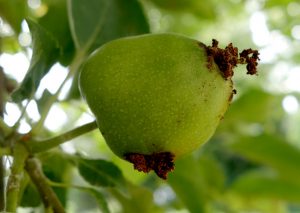 . Be sure to read the instructions at the top of the page, for how to read the table.
. Be sure to read the instructions at the top of the page, for how to read the table.
At most sites, codling moths are finishing up the “period of greatest egg hatch,” where 75% of all eggs for the first generation are hatching. In high population areas, time your last spray of the first generation to protect fruit up to the end of egg hatch as shown on the table.
Your next application should occur at the date for the start of second generation egg hatch, or if you can tolerate higher injury or have a low population, apply your next spray at the start of “second generation peak egg hatch”.
Treatment
San Jose Scale
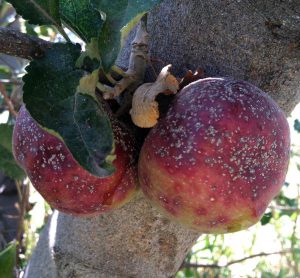
Scales are immobile insects with a hard “shell.” They feed on tree sap through a straw-like mouthpart. They are often difficult to see with the naked eye; a 10-20x hand lens helps.
San Jose scale (SJS) primarily occurs on apple. It looks like a small pimple or large pepper flake. It can be found on fruit, twigs, scaffold branches, and the main trunk.
If your trees have SJS and you applied a dormant oil spray, most overwintering adults will have survived that spray. Therefore, a treatment targeting newly hatched nymphs (called crawlers) will need to be applied. Each adult female lays about 200 eggs. The crawlers walk or are windblown to new sites to settle on twigs or fruit, insert their mouthparts, and feed for the remainder of their lives. Once they form their hard outer covering, they are more resistant to pesticides.
If the scale population is left untreated, the fruit becomes small and deformed. The tree loses vigor and branches may start to die. It is primarily a problem in standard-sized, poorly pruned trees.
Treatment timing windows:
- Cache and northern Box Elder counties, and high elevation areas: June 27 – 30
- Warmer Wasatch Front locations: June 20 – 21
- Cooler Wasatch Front locations: June 23 – 24
- Carbon and Iron counties: June 20 – 21
Residential Materials to use:
- Organic: insecticidal soap (apply three times 5 days apart); horticultural oil (apply 3 times 5-7 days apart)
- Conventional: Ortho Flower, Fruit & Vegetable (apply once); Spectracide Triazicide (apply once)
Commercial Materials to Use:
- click here; Esteem or Centaur work best
PEACH/NECTARINE, APRICOT
Greater Peachtree Borer
Spray lower trunks in Wasatch Front, Iron County, and northern Washington County locations now
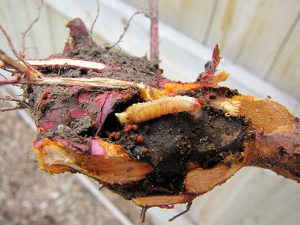
The greater peachtree borer is a moth, and we had our first report of this insect over the weekend. Spraying the lower trunks (10″ up plus exposed roots) with an insecticide will kill any eggs that are laid by the female moths. Otherwise, a larva will hatch and immediately bore into the tree trunk and feed on the inner bark and cambium.
There they stay until the following spring. This is when people notice gumming mixed with frass at the base of the trunk, or even just below the soil line.
Timing for Other locations:
- Cache: July 1
- Wasatch Front, cooler areas: June 27
Treatment:
- Residential: permethrin, such as Hi Yield: Apply at the appropriate timing, and repeat once per month, with the last application in September.
- Organic options are products that contain either pyrethrin or azadirachtin (BioNeem), but need to be applied weekly.
- Commercial: click here
Peach Twig Borer
First generation egg hatch is ending soon in certain locations.
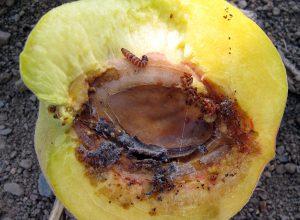
View a pdf of the spray timing table.
Second generation of peach twig borer egg hatch will begin in mid-July for most areas. Fruit becomes more susceptible to attack by twig borer larvae when it is softer, and one application at the beginning of second generation should suffice for most areas.
Treatment
- Commercial: For options, click here.
- Residential: Treatment options are the same as for codling moth.
CHERRY
Western Cherry Fruit Fly
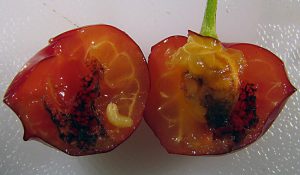
Sweet cherries are near ripe in certain areas while tart cherries have a few weeks to go. If you need to spray your ripening cherries one last time before harvest, be mindful of the pre-harvest interval, whether you are a farmer or homeowner.
Treatment Options – Backyard Growers
Conventional:
- Malathion (malathion): pre-harvest interval is 14 days
- Ortho Flower, Fruit, and Veg. (acetamiprid): Only the concentrate container includes cherry on the label; pre-harvest interval is 10 days
- Garden Tech Sevin (cyfluthrin); pre-harvest interval is 14 days
- Bonide Fruit Tree Spray (carbaryl): pre-harvest interval is 14 days
- Spectracide Triazicide (gamma-cyhalothrin): pre-harvest interval is 14 days
Organic:
- Fertilome / Gardens Alive / Bull’s Eye / Monterey (spinosad): pre-harvest interval is 7 days
- Safer BioNEEM (azadirachtin): every 7 to 10 days; pre-harvest interval is 0 days
Treatment – Commercial Growers
- Commercial growers, click here.
